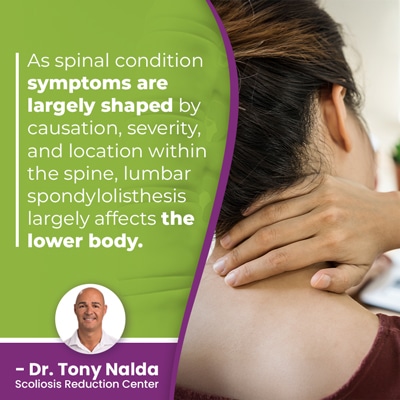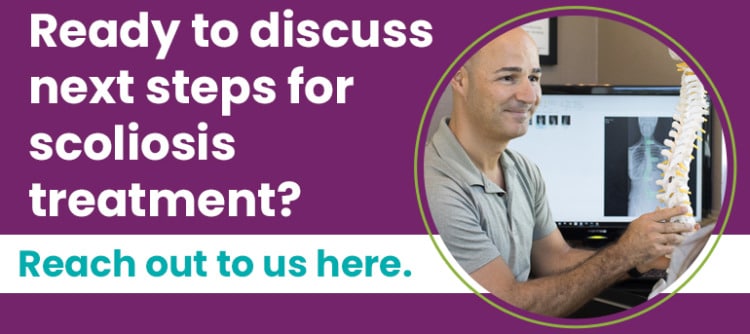Understanding Spondylolisthesis: Symptoms & Best Treatments

Spondylolisthesis can develop when a vertebral body slips out of its alignment with the rest of the spine; it can slip forward and down onto the vertebral body below, causing uneven pressure and irritating nerves.
The spine is designed for movement, but if there is too much movement within the spine due to a vertebra slipping out of place, this is a condition of spinal instability known as spondylolisthesis. Symptoms can include pain and mobility issues, and treatment should be shaped by the underlying cause of the instability.
Table of Contents
What is Spondylolisthesis?
The health of the spine is directly related to the health of its curves. The spine has three main sections: the cervical spine, thoracic spine, and the lumbar spine.
Each spinal section has its own unique curve type and roles to play in how the spine functions.
The spine consists of vertebrae (bones) that are stacked on top of one another in a straight and neutral alignment, but if one or more vertebrae become misaligned, it can disrupt the entire spine's stability.
If a vertebra slips out of alignment and falls forward onto the vertebra below, this is known as spondylolisthesis and can cause a number of issues.
Where Does Spondylolisthesis Develop?
Spondylolisthesis can develop anywhere in the spine, but it's most commonly associated with the lumbar spine.
The lumbar spine is vulnerable to a number of issues/conditions because of the roles and responsibilities of the lower back.
In fact, it's said that everyone will experience lower back pain at some point, and this is because the lumbar spine not only has to support the weight of the spinal sections above and the entire trunk, its vertebrae feel the effects of strenuous movement such as bends, lifts, and twists.
Considering the extra strain on the lumbar spine's vertebrae, it makes sense that these vertebral bodies are the most vulnerable to instability, and when there is instability, there is a higher risk of injury and strain.
An unstable spine is one that can become off-balanced, and if the spine is unbalanced, it's common that general movement, balance, and coordination are disrupted.
 As spinal condition symptoms are largely shaped by causation, severity, and location within the spine, lumbar spondylolisthesis largely affects the lower body.
As spinal condition symptoms are largely shaped by causation, severity, and location within the spine, lumbar spondylolisthesis largely affects the lower body.
Lumbar Spondylolisthesis Symptoms
While some people don't experience noticeable symptoms, others can experience several at a time.
When it comes to spondylolisthesis that develops in the lumbar spine, common symptoms can include lower back pain, spinal rigidity, sciatic nerve pain, tight hamstring muscles, and the development of an unhealthy spinal curve.
When severe, spondylolisthesis can contribute to the development of cauda equina syndrome, characterized by a loss of feeling in the legs and bladder issues, and this is a severe neurological complication that can require immediate medical attention.
Pain can develop because the spine is experiencing adverse spinal tension, compression, and because there is too much movement and instability within the spine.
A stiff spine can develop as movement changes occur, and sciatic nerve pain is also a common complication because the sciatic nerve starts in the lumbar spine.
If a vertebra slips forward in the lower back and causes compression of the sciatic nerve, symptoms can develop anywhere along the sciatic nerve's extensive pathway throughout the lower body.
Tight leg muscles can develop as the lower body works harder to try and compensate for the instability in the lower back.
The development of an unhealthy spinal curve can also occur as the spine becomes increasingly unstable and unbalanced.
Scoliosis and Spondylolisthesis
So what's the connection between scoliosis and spondylolisthesis?  It's not entirely understood what causes idiopathic scoliosis to develop, but it does appear that spinal instability can contribute to the development of scoliosis.
It's not entirely understood what causes idiopathic scoliosis to develop, but it does appear that spinal instability can contribute to the development of scoliosis.
If the lumbar spine is misaligned due to spondylolisthesis, it can be particularly vulnerable to the development of an unnatural sideways bending and rotating spinal curve: scoliosis.
And as scoliosis is progressive, the nature of the condition is to increase in severity over time, and when it comes to degenerative scoliosis, these cases are almost always painful because the spine can become increasingly unbalanced and unstable.
Degenerative scoliosis and degenerative spondylolisthesis affect older adults, and both are also more commonly diagnosed in females due to changes in bone density and hormones related to menopause.
Older individuals with spinal instability are in constant danger of injury from a fall, and balance and stability needs to be restored to the spine and core.
When it comes to treating spondylolisthesis, the underlying cause has to be determined and addressed.
Spondylolisthesis Causes
There are different types of spondylolisthesis, determined by its causation.
Congenital spondylolisthesis makes some people particularly vulnerable because the spine doesn't form properly in utero; vertebral malformations can compromise the spine's ability to stay aligned.
Degenerative spondylolisthesis is the most common type to affect adults, and it can be caused by natural age-related degenerative changes in the spine. Conditions like osteoarthritis can weaken the spine's joints and discs, causing slippage in the vertebrae.
Isthmic spondylolisthesis is caused by a stress fracture in the pars interarticularis due to an overuse injury. This type of fracture can weaken the vertebrae and contribute to instability and slippage.
Traumatic spondylolisthesis is caused by an accident and/or trauma experienced by the spine, like a fall that compromises the spine's integrity.
Post-surgical spondylolisthesis isn't common but involves a spinal surgery weakening the spine and contributing to the type of instability where one vertebra slips down onto the bone below; low grade spondylolisthesis can occur after surgical management.
Pathologic spondylolisthesis is caused by the presence of an underlying condition like an infection or spinal tumor weakening a vertebra and causing it to slip.
When it comes to treatment options, different condition types will have different needs.
Spondylolisthesis Treatment Options
When it comes time to address spondylolisthesis, a common focus is symptom relief.
As is the case with most spinal conditions, there are two main treatment options: conservative or surgical.
Conservative treatment options can include lifestyle modification, rest, physical therapy, bracing, chiropractic care, steroid injections, and medication.
Lifestyle modification can help when adverse spinal tension can be reduced by weight loss and improvements to posture and activity levels.
Rest and activity restrictions can help when the spine's instability is caused by an overuse injury, and physical therapy can help improve the spine's surrounding muscle strength for more support/stability.
Bracing can help by stabilizing the spine, especially in the case of fractures, and this can help reduce movement within the spine and provide short-term pain relief.
When a spinal condition like scoliosis is the cause, condition-specific chiropractic care can help by working towards correcting the unnatural spinal curve on a structural level and restoring the spine's alignment and stability.
Steroid injections can help with reducing inflammation and temporary pain management.
Prescription medications can also help reduce inflammation and pain, but again, these solutions are temporary, unless the underlying cause of the spine's instability is addressed.
Surgical management can be recommended for congenital spondylolisthesis and/or particularly severe cases and can conclude decompression, spinal fusion surgery, and/or a combination of the two procedures.
Conclusion
Spondylolisthesis is diagnosed if a vertebra slips out of alignment with the rest of the spine and onto the bone below; this can introduce adverse spinal tension and compression to the area.
Spondylolisthesis symptoms are shaped by a number of factors including patient age, location within the spine, severity, and type.
Spondylolisthesis symptoms commonly include back pain, mobility issues, leg pain, nerve pain, and the development of unhealthy spinal curves.
Symptoms are largely felt in the area of the body located the closest to the slipped vertebra.
Spinal instability capable of causing a vertebra to shift can be caused by a number of reasons: degeneration in the spine, a malformed spine that develops in utero, stress fractures, overuse injuries, trauma, surgery, and/or an underlying pathology like an infection or bone tumor pressing on the spine.
An unstable spine means an unstable body, and a spine that's misaligned can cause effects felt from the head to the feet; the spine gives the body structure and facilitates its ability to practice straight upright posture.
Here at the Scoliosis Reduction Center®, scoliosis is treated proactively and effectively with nonsurgical treatment options, and when scoliosis causes a complication such as lumbar spondylolisthesis or sciatic nerve pain, the underlying cause (the scoliosis) is the focus of treatment.
When it comes to preventing spinal instability, maintaining a spine-friendly lifestyle can help: maintaining a healthy weight, activity level, strong core, lifting heavy objects properly, not consuming excessive amounts of alcohol and/or smoking, and staying hydrated.
Dr. Tony Nalda
DOCTOR OF CHIROPRACTIC
After receiving an undergraduate degree in psychology and his Doctorate of Chiropractic from Life University, Dr. Nalda settled in Celebration, Florida and proceeded to build one of Central Florida’s most successful chiropractic clinics.
His experience with patients suffering from scoliosis, and the confusion and frustration they faced, led him to seek a specialty in scoliosis care. In 2006 he completed his Intensive Care Certification from CLEAR Institute, a leading scoliosis educational and certification center.
About Dr. Tony Nalda
 Ready to explore scoliosis treatment? Contact Us Now
Ready to explore scoliosis treatment? Contact Us Now





